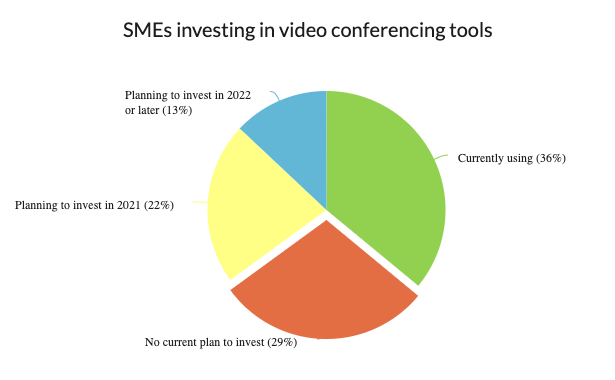Is it worth paying for video conferencing software?
- Last Updated : June 12, 2023
- 574 Views
- 5 Min Read

The COVID-19 outbreak has forced business owners to rethink the way they run their business as we continue toward an increasingly digitised world. Amidst the travel limitations that confined us to our homes, video conferencing apps saw a tremendous surge in usage. Whether to celebrate a birthday of a loved one or attend weekly team meetings, people today rely extensively on video conferencing solutions to lead a life that's (as close to) normal as possible from the safety of their homes.
Even once the pandemic has become a distant memory, many businesses will still be embracing a WFH model to some degree, and teams will naturally become more dispersed across geographical regions. For these remote employees, video conferencing will be the only way for them to get together with their peers and have face-to-face interactions. This not only helps people stay productive while working remotely, but it can also save a ton of time and travel expenses for businesses.
Identifying the right video conferencing tool
Every video conferencing service has its pros and cons and will differ by the range of features it offers. If you're in the market for a tool like this, it's vital to ensure that the software you are selecting aligns with your business process.
Here's a list of questions to consider before deciding which video conferencing software is right for you:
How long are your video meetings on average?
How many participants usually join each session?
If that number is large, can the product handle that volume?
If the number is small, are you paying for more than you need?
Is the software going to be used purely internally or both internally and externally?
If externally, will your customers be willing to download a third-party app to attend your meetings, or would they prefer to join without having to sign up or create an account?
Does the software provide a good quality experience to customers joining meetings from their tablet or mobile device?
How many employees from your organisation would need to use the software to host meetings?
How often do you expect to conduct meetings?
Will your video conferencing tool be able to integrate with other apps, like your calendar, CRM, or email marketing tool?
With these details in hand, it will be easier to narrow down your choices and easily choose the best solution for your business.
Video conferencing features
Most video conferencing solutions offer a similar set of standard features, and for many, those will be more than enough to meet their business requirements. Here's a list of features that a good video conferencing tool will let you have for free:
Unlimited one-to-one meetings and limited group meetings
Automated meeting reminders
Screen sharing
Private or group chats
Speaker spotlight
Recordings with local disk storage
Browser option for joining
End-to-end encryption
Now, when there are so many amazing free features, why would someone would pay to use such services? Well the truth is that many of the additional features that paid editions of these products have can help businesses grow, especially as they begin hiring more employees and reaching out to more regions with their products.
Here are three key reasons why investing in video conferencing technology can be worth your money:
1. Free yourself (and your customers) from limitations
When using free video conferencing software, you must constantly be mindful of exceeding time restrictions or keeping the number of participants to a minimum. This can be a huge drawback for organisations that rely on video conferencing to engage and educate their customers. For instance, let's say you're hosting online yoga classes for a group of people, and you unexpectedly exceed the permitted time. Your call will be disconnected, and you might have to request that your participants rejoin by sending them a new meeting link. By then, drop-off rates will skyrocket. Even worse would be if you have more demand for your services than free meetings will allow you to supply. With each meeting, you'd be losing out on revenue.
If you're looking to accommodate your customers and provide an exceptional remote experience, it won't hurt to pay a few extra bucks to upgrade your service and have the freedom to host meetings for as long as you want and with as many people as you'd like.
2. Take advantage of additional features
Upgrading your video subscription service from a free or basic version to the premium edition can unlock additional features that improve both your employee and customer experience. Most paid video conferencing tools will include intuitive features such as:
Custom meeting codes: Personalise your meeting access key or password with preferred numbers of your choice or your customer's phone number for easy access.
Branding: Personalise your email headers or your webinar registration forms with your brand logo, feature image, name, and more.
Social media streaming: Stream your online events to a larger audience across social channels like YouTube and Facebook.
Live Q/A and polls: Run interactive polls to increase participant engagement and make each session more productive. This will help you easily identify people who are genuinely interested in your brand.
Video recordings with increased cloud storage, so employees can refer back to meetings for key points or to improve customer engagement.
Reporting: Keep track of attendance, number of scheduled meetings, and the duration of your meetings.
Intelligent noise cancellation: Reduce unwanted background noise to improve your meeting audio quality.
Multiple-user licenses: Allow multiple people in your organisation to schedule, invite and host meetings.
3. Gain a competitive advantage

In April 2021, Zoho collaborated with Telsyte to conduct a workplace study on Australia's small and medium-sized businesses. From surveying 307 decision-makers in Australian organisations that have less than 100 employees, we found that 36% were already using video conferencing tools in their business. 22% planned to invest in them in 2021 and 13% in the year 2022 or later. No matter the size, Australian businesses have clearly realised that it's worth spending money to deliver a good customer experience. When other organisations are continually enhancing their operations, you need to do the same if you wish to stay a step ahead of your competition.
We hope this post gives you some guidance when choosing the video conferencing software that best fits your business requirements. From improving collaboration to ensuring customer loyalty, video conferencing tools have enormous potential to benefit businesses of all sizes and industries.
If you are looking to invest in secure video conferencing software that doesn't burn a hole in your pocket, Zoho Meeting is a great option. Our online meeting software is easy to use and has a range of useful features available as part of both free and premium versions. At Zoho, we tailor and build our products to meet your specific needs, and our goal is to help SMEs around the world keep up with the pace of technological innovation and thrive in today's digital age.


